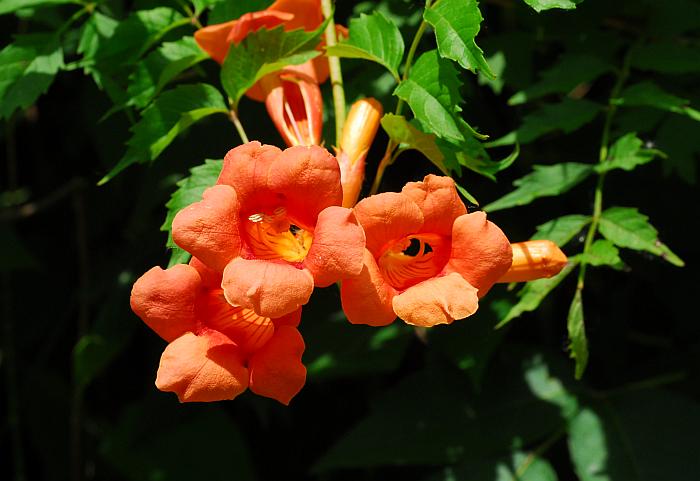Campsis radicans (L.) Bureau
Trumpet Creeper

Native
CC = 3
CW = 0
MOC = 71
© SRTurner
Campsis radicans (L.) BureauTrumpet Creeper | |
 |
Native CC = 3 CW = 0 MOC = 71 |
© SRTurner |
|
Family - Bignoniaceae Habit - Perennial liana, unarmed and lacking tendrils, creeping or climbing, with aerial rootlets along the stems. Stems - Climbing or clambering, to 20 m, multiple from base. New growth glabrous, green Older stems woody with yellowish brown bark often peeling in thin strips.
Leaves - Opposite, petiolate, odd-pinnate, with 7-11 leaflets. Rachis glabrous or hairy, with a narrow adaxial groove, green. Leaflets opposite, lanceolate to ovate, acuminate, coarsely toothed, glabrous above, sparsely pubescent on veins below, 2-8 cm long, 4 cm broad. Leaflet stalk short, winged.
Inflorescence - Terminal panicles of up to 10 flowers. Pedicels to 1.7 cm long, subtended by small linear bracts. Pedicel also often with two small scalelike bracts near middle.
Flowers - Calyces 15-22 mm long, 5-lobed, glabrous (but with scattered inconspicuous glands toward the base of the lobes), reddish green or orange, the lobes triangular, shorter than the tube. Corollas 6-9 cm long, funnelform, somewhat zygomorphic, glabrous, thickened, somewhat waxy-textured, red to reddish orange, yellowish orange toward the base, 5-lobed, only slightly 2-lipped, the tube narrowly bell-shaped to nearly cylindrical, the lobes much shorter than the tube, somewhat overlapping, the upper 2 lobes slightly smaller than the others, the margins entire or slightly irregular. Stamens 4, included, fused to base of corolla tube. Staminodes absent. Filaments to 3 cm long, glabrous, pale yellow. Anthers tan, 5-6 mm long. Style 1, 4.8 cm long, glabrous, yellow-green. Stigma flattened, spatulate, to 3 mm broad. Ovary superior, 8 mm long, subterete to weakly 6-angled. Placentation axile. Ovules many, glabrous. Capsules 2-valved, to +15cm long, beaked, woody. Seeds winged.
Fruits - Linear-elongate capsules, 10-28 cm long, 2-valved, slightly flattened, elliptic in cross-section with noticeable ridges along the sutures between the valves, the valves glabrous, with a leathery texture, tan to brown at maturity. Seeds with the body 6-9 mm long, flattened, the body elliptic in outline, 2-lobed, brown, with a wing at each end, the wings papery, light tan, with irregular margins.
Flowering - May - August. Habitat - Open woods, thickets, fence rows, roadsides, railroads, disturbed sites. Also cultivated. Origin - Native to the U.S. Lookalikes - Distantly, Bignonia capreolata. Other info. - This striking species is common throughout Missouri. Its U.S. distribution is mainly within the eastern half of the country, and also ranges into Canada. The plant is easily identified by its large, trumpet-shaped flowers which are entirely red. The leaves are also quite distinctive. Photographs taken off Hwy W, Ripley County, MO., 6-5-04 (DETenaglia); also at various points along the Katy Trail, 6-25-2010, 9-15-2011, 6-13-2017, and 8-18-2023, near Labadie, Franklin County, MO, 6-16-2016, and in Washington, Franklin County, MO, 5-25-2012 (SRTurner). |